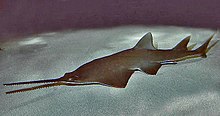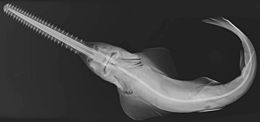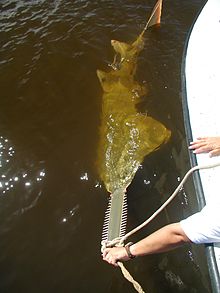Smalltooth sawfish
| Smalltooth sawfish | |
|---|---|

| |
| Pristis pectinata in Aquarium of the Americas
| |
| Scientific classification | |
| Domain: | Eukaryota |
| Kingdom: | Animalia |
| Phylum: | Chordata |
| Class: | Chondrichthyes |
| Subclass: | Elasmobranchii |
| Superorder: | Batoidea |
| Order: | Rhinopristiformes |
| Family: | Pristidae |
| Genus: | Pristis |
| Species: | P. pectinata
|
| Binomial name | |
| Pristis pectinata Latham, 1794
| |

| |
| IUCN range
Extant (resident)
Possibly extinct
Presence uncertain
| |
The smalltooth sawfish (Pristis pectinata) is a species of
Distribution and habitat
The smalltooth sawfish is found in tropical and subtropical parts of the Atlantic, including the Caribbean and Gulf of Mexico. Its original range was the smallest of the sawfish species, covering about 2,100,000 km2 (810,000 sq mi).[5] In the west it once ranged from the United States to Uruguay and in the east from Senegal to Angola.[1] Today it has disappeared from much of its historical range.[5] There are old reports from the Mediterranean Sea, but this likely involved vagrants[5] and according to the FAO the species can be considered locally extinct in the Mediterranean Sea.[6]
Smalltooth sawfish are mostly found in coastal marine and
Appearance
The smalltooth sawfish reputedly reaches a total length of up to 7.6 m (25 ft),[10] but this is likely an exaggeration and the largest confirmed size is 5.54 m (18.2 ft).[4] It weighs up to 350 kg (770 lb).[10]
Its upperparts are brownish-gray, gray, bluish-gray or blackish, and the underparts are whitish.[4][11]
Unlike the
Function of the saw

For feeding
For many years, rarity of seeing a sawfish in the wild prevented scientists from collecting conclusive evidence about the use of their distinctive rostrum. This led them to falsely assume that the sawfish, like many other marine vertebrates with a "beak," or an elongated rostrum, follow the rule that the appendage is used to either sense prey or capture prey, but never both. There are no other highly studied marine animals with similar rostral characteristics that have shown that the rostrum is used for both of these feeding techniques. Recent studies have demonstrated, however, that the sawfish utilize their rostrum to both sense and manipulate prey.[14]
A sawfish's saw is made up of thousands of
Sawfish were thought to primarily prey upon sand dwelling
It is believed that the elongated rostrum first evolved for its use in prey immobilization.[16] Smalltooth sawfish have been observed to approach large shoals of fish while striking their saw rapidly from side to side. Due to the high density of small fish in a shoal, there is a high probability that the sawfish will hit, stab, stun, or kill several prey during one shoal attack.[22]
Vertebrate biologist Barbara Wueringer, of the University of Queensland, demonstrated that sawfish use their extended rostrum to detect and manipulate prey. She observed the animals' reaction to food already at the bottom of the tank, food falling from the water's surface, and introduced electric dipoles.
For defense
The many teeth of a sawfish's saw are not actually teeth at all, but rather special types of scales known as
Reproductive behavior

The reproductive behavior of smalltooth sawfish has not been well studied, despite their classification as a
Smalltooth sawfish have recently been observed, for the first time, to reproduce parthenogenetically in the wild. About 3 percent of the sawfish living in a Florida estuary are the result of parthenogenesis. The research team speculates that since smalltooth sawfish are so rare, females might sometimes fail to find a male during the mating season, inducing the parthenogenetic process.[29]
Elasmobranchs are
Conservation status


Smalltooth sawfish are extremely vulnerable to

Small numbers are maintained in
In early 2024, state and federal wildlife agencies in Florida, USA, became aware of an "unusual mortality event" from an unknown cause.[35] Affected fish exhibited spinning or whirling behavior. An effort was being made to rescue and rehabilitate affected fish.[36]
See also
- Threatened rays
Notes
References
- ^ . Retrieved 20 May 2023.
- ^ "Appendices | CITES". cites.org. Retrieved 2022-01-14.
- .
- ^ ISBN 9780643109148.
- ^ doi:10.1002/aqc.2525.
- ^ Mendez, L.; Bacquet, A.; Briand, F. (2022). "List of locally extinct species". Guide of Mediterranean Skates and Rays. The Mediterranean Science Commission (CIESM). Retrieved 16 July 2023.
- ^ a b c d Whitty, J.; Phillips, N. & Scharfer, R. "Pristis pectinata (Latham, 1794)". Sawfish Conservation Society. Retrieved 17 November 2017.
- JSTOR 24321140.
- ^ a b "Sawfish Myths". University of Florida. 2017-05-04. Retrieved 27 November 2017.
- ^ a b Froese, Rainer; Pauly, Daniel (eds.) (2006). "Pristis pectinata" in FishBase. April 2006 version.
- ^ ISBN 978-0-8018-9838-9.
- JSTOR 1442018.
- ^ S2CID 3352391.
- ^ ISBN 9781440560262.
- S2CID 16357946.
- ^ S2CID 3352391.
- ISSN 0025-3154.
- ^ JSTOR 1438539.
- ^ ISSN 1863-5407.
- PMID 16313606.
- PMID 31797939.
- ^ ISBN 978-1577855385.
- PMID 22401891.
- JSTOR 1442018.
- ^ a b Alan D. Henningsen; Malcolm J. Smale; Ian Gordon (2001). "Captive Breeding and Sexual Conflict in Elasmobranchs" (PDF). Elasmobranch Husbandry Manual: Proceedings of the First International Elasmobranch Husbandry Symposium. Archived from the original (PDF) on 4 October 2013. Retrieved 4 October 2013.
- ISBN 978-0-86727-152-2.
- ^ )
- ^ Tonya R. Wiley; Colin A. Simpfendorfer; Vicente V. Faria & Matthew T. Mcdavitt (2008). "Range, sexual dimorphism and bilateral asymmetry of rostral tooth counts in the smalltooth sawfish Pristis pectinata Latham (Chondrichthyes: Pristidae) of the southeastern United States" (PDF). Zootaxa. Retrieved 4 October 2013.
- ^ "Critically Endangered Ocean Giant is Reproducing Without Sex in the Wild |". June 2015.
- ^ NOAA Fisheries (2 January 2015). Smalltooth Sawfish (Pristis pectinata). Endangered Species Act. Retrieved 8 June 2015.
- ^ "The endangered Smalltooth Sawfish gives birth at Atlantis, Paradise Island". Bahamas Local. 31 May 2012. Retrieved 17 November 2017.
- ^ )
- ^ "Sawfish in Aquariums and the Media". Sawfish Conservation Society. Retrieved 17 November 2017.
- ^ "Sawfish are spinning, and dying, in Florida waters as rescue effort begins". Yahoo News. 2024-03-28. Retrieved 2024-03-29.
- ^ Mazzei, Patricia (April 15, 2024). "What's Killing Endangered Sawfish in Florida?". The New York Times. Retrieved April 16, 2024.
External links
 Media related to Pristis pectinata at Wikimedia Commons
Media related to Pristis pectinata at Wikimedia Commons Data related to Pristis pectinata at Wikispecies
Data related to Pristis pectinata at Wikispecies- Species Description of Pristis pectinata at www.shark-references.com
- NOAA Fisheries smalltooth sawfish web page
- Photos of Smalltooth sawfish on Sealife Collection

